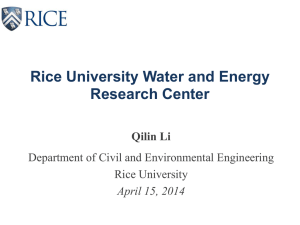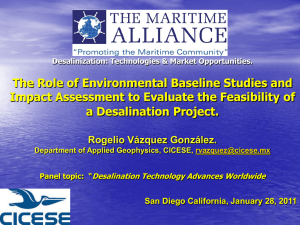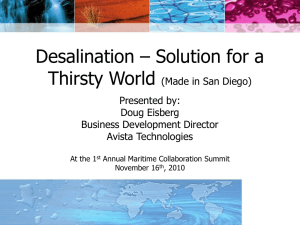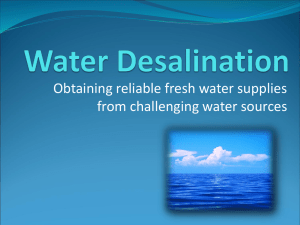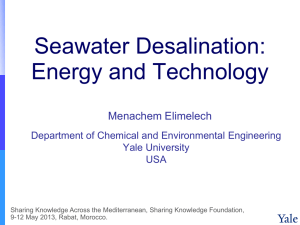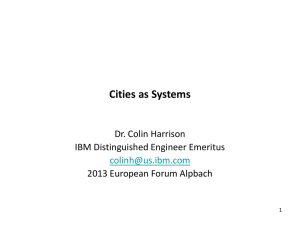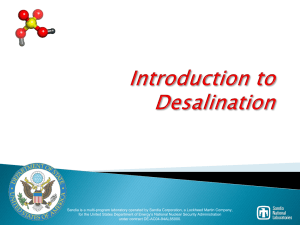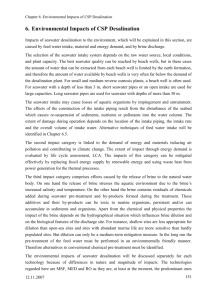The Qatar Sustainable Water & Energy Utilization Initiative (QWE)
advertisement
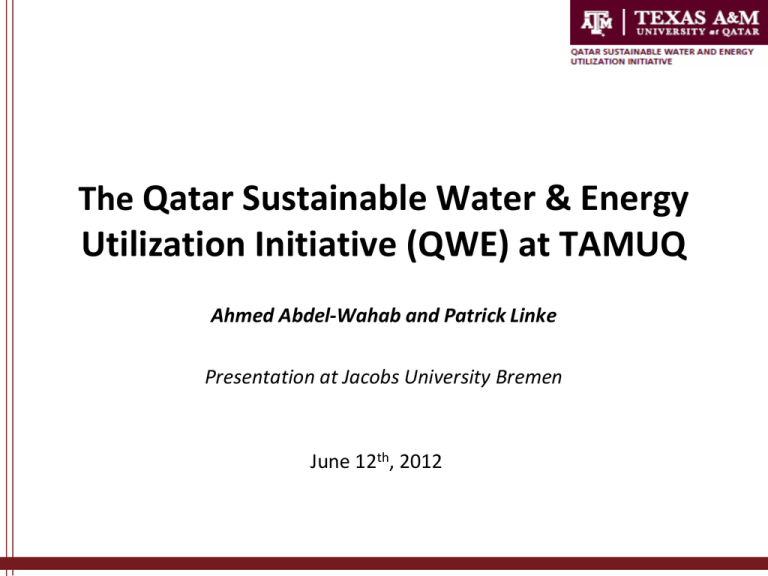
The Qatar Sustainable Water & Energy Utilization Initiative (QWE) at TAMUQ Ahmed Abdel-Wahab and Patrick Linke Presentation at Jacobs University Bremen June 12th, 2012 QWE The Qatar Sustainable Water and Energy Utilization Initiative • Center of Excellence at TAMUQ since 2008 • Water, energy, environment • Activities Research and development, technical service, capacity building, outreach • Supporting Qatar’s development in partnership Advisory Board, engagement at national and international level • Critical mass 3 faculty, approx. 40 staff, Grad and UG students, strong research funding, world class experimental and computational facilities Capabilities • Faculty with complementary expertise • Well-qualified staff • World class laboratories and computational facilities that are continuously upgraded and expanded Capabilities (cont.) • Experimental capabilities – State-of-the-art equipment for water/wastewater, and soil analysis. – Range of high-performance gas and liquid chromatographs/mass spectroscopy and spectrophotometers. – Laboratory analytical capabilities include physical, chemical, and biological parameter testing of samples with a variety of matrices, including water, wastewater, soils and sludges. – The laboratories maintain a comprehensive Quality Assurance and Quality Control Program. Capabilities (cont.) Computing and simulations capabilities – Modeling, simulation and optimization of water, energy and processing systems – Development of systematic methods and tools • Model-based process innovation platforms • Computer-aided molecular design • Integrated materials and process design • Systems integration (energy, water) and Infrastructure planning – Focus on multi-level approaches (from concept to detail) and integration across scales (microscopic to macroscopic) – Optimization algorithms, Grid Computing, Knowledge Management / semantics QWE Activities • Research – Excess of $10M research funding since inception – Address problems related to the needs of Qatari stakeholders – Provide knowledge and technology transfer to stakeholders • Technical Service – Conduct water/wastewater, soil, and sludge samples analysis – Modeling simulation/optimization studies – Technology assessments – Provide technical support to stakeholders QWE Activities (cont.) • Human Capacity Building – Organize practical training programs, workshops and seminars for engineers and practitioners from Qatari industrial and governmental agencies on several aspects of water, environmental, and energy systems. – The emphasis is on “learning by doing” – We utilize the QWE existing world-class laboratories for these training courses. – We transfer the findings of our research to the classroom and, hence, give students a hands-on experience Current Research Activities – Environmental impact assessment and management • Environmental impact of cooling water and wastewater discharge • Regulatory revisions and recommendations of new standards • Design of discharge/outfall systems – Desalination Process Innovation • Zero liquid discharge systems (ZLD) • Hybrid desalination systems – Advanced water and wastewater treatment processes • Advanced reduction processes • Advanced oxidation processes • Electrochemical treatment processes – Hazardous Waste Management • Hazardous waste treatment • Utilization of modified byproduct sulfur for hazardous waste treatment Current Research Activities (cont.) - Process Design, Integration and Systems Engineering Integrated water resources management Macroscopic water systems design and optimization Materials and design innovation for Organic Rankine Cycles Desalination process innovation, hybrid desalination systems, solar desalination Industrial energy recovery and reuse Renewable energy / systems integration Process design and optimization for the efficient use of energy and raw materials Selected ongoing R&D Projects Water and Environmental Engineering Inland Desalination for Brackish Water with Zero Liquid Discharge Inland desalination using reverse osmosis is a common practice Brine discharge from inland desalination is a major environmental problem Achieving zero liquid discharge will avoid the problems of brine disposal and maximize recovery Available zero liquid discharge technologies are used mainly in industrial applications and they are prohibitly expensive for inland desalination This project focuses in developing costeffective and environmentally benign process for inland desalination with zero liquid discharge ZLD schematic diagram. Brackish water Advanced Evaporation system RO 1 Brin e Treatmen t before RO 2 RO2 Concentrated brine Produced water A Holistic Approach for Sustainable Use of Industrial Seawater Cooling (Sponsor: QNRF) Chloroform • Develop quantitative techniques for predicting the reaction mechanisms and kinetics of biocides and their reaction products in seawater • Develop computational tools to predict the fate and transport of biocides and their reaction products • Aid in developing sound regulatory policies Concentration (μMol) • Develop a scientific framework for environmental impact assessment of cooling water discharge into seawater BOCM BBCM Bromoform 0.6 0.5 0.4 0.3 0.2 0.1 0 0 50 100 Reaction Time (hrs) 150 200 Study of Residual Chlorine and Chlorinated Byproducts at MIC Industrial Area (MoE, QAFCO, QAPCO, QP) Field Sampling and Analysis Kinetic Modeling Lab Experiments Hydrodynamic Modeling Modeling Experimental Impact Toxicity Analysis Recommendations for Residual Chlorine Standards Reactive Transport Modeling Assessment of Environmental Impact of Brine Discharge from Halul Desalination Plant Advanced Reduction Processes for Hazardous waste Treatment 7 Chlorinated organics found in industrial wastes pose a global threat to the environment 5 Absorbance Oxidation-reduction reactions are the primary method for destroying these contaminants a) Aerobic 6 4 S2- 3 2 S2O42- The requirement to achieve desired levels of destruction within a reasonable time is often not met 1 SO32- 0 200 250 300 350 400 Wavelength(nm) 7 b) Anaerobic 5 Absorbance Unfortunately, there are currently no approaches available that are capable of cost-effectively destroying many persistent chlorinated organics. 6 S2O42- 4 3 S2- SO32- 2 This research aims at developing cost-effective treatment methods in order to enable sustainable operation of industrial processes while protecting the environment 1 0 200 250 300 Wavelength(nm) 350 400 Removal of Heavy Metals from water/wastewater using Reactive Adsorbents • Recycle/reuse is one of the key solutions for efficient water management and minimizing environmental impact • Heavy metals found in recycled wastewater are major challenge • Adsorption is the primary process for heavy metals removal • Residuals produced by the process are unstable when disposed in landfills Nano-Particulate Iron Sulfides • They can leach to the environment after disposal • Application of nano-particulate iron sulfides (FeS, FeS2) • Different removal mechanism; initial removal on the surface followed by surface reactions that would convert the toxic compounds to stable solid phase Mackinawite (FeS) Pyrite (FeS2) As(III) Selenite(SeO32-) As(V) Target compounds (As (III, V), Hg(II), Se(IV, VI)) Selenate (SeO42-) Stabilization Disinfection Byproducts Removal from Water using Advanced Reduction Processes (ARPs) • Disinfection byproducts are major concern in desalination systems • Bromate and chlorate are emerging contaminants • They are harmful to human health and the environment • They are persistent contaminants and difficult to destroy • This project investigate destruction of these contaminants using ARPs Techno-Economic Study and Assesment of Environmental Impact of Seawater Dechlorination • Evaluate effectiveness and cost of three different dechlorinating chemicals • Evaluate optimum doses and dosing schemes • Evaluate environmental impact 120 100 Free Chlroine removal (%) • Kinetic and equilibrium experiments Free chlorine removal vs. time during dechlorination of seawater containing different chlorine doses using sodium thiosulfate 80 Time vs 0.25 Free Chlorine Time vs 1.0 Free Chlorine Time vs 2.5 Free Chlorine Time vs 5.0 Free Chlorine Time vs 10.0 Free Chlorine 60 40 20 0 0 10 20 30 40 50 Time (hours) 60 Utilization of Byproduct Sulfur for Hazardous Waste Treatment • Managing byproduct sulfur from natural gas processing is a key aspect of economic development and environmental protection in Qatar • New markets must be found for sulfur to avoid disposal crises • One attractive use of byproduct sulfur is to treat hazardous wastes • The goal of this project is to investigate use modified sulfur products to degrade and immobilize hazardous materials and to demonstrate their use to treat contaminated wastes 11 Final Cr(VI) Concentration (mg/L) • Sulfur cement can be applied as a primary binder in solidification/stabilization (S/S) treatment of hazardous wastes 10 9 8 7 6 5 4 3 2 1 0 0 2 4 6 8 10 12 14 Time (hrs) 16 18 20 22 24 Process Systems Engineering – Energy and Water Policies & Regulations Integrated System Design of optimal desalination processes and systems Synthesis of optimal membrane desalination processes (RO, RO-NF, …) Technologies Process Better membrane element models for process analysis Process Design: Optimal process configurations Process systems optimization: Value extraction & energy integration (renewables) Macro-system: Integration with water/energy infrastructures, infrastructure design Infrastructure Systems integration and design Policies & Regulations Integrated System Systematic optimal design and selection of membrane-based desalination processes Technologies Develop performance target Use models to screen through large numbers of potential design candidates to identify the best Design insights on the way to the target Understand flexibility in design and benefits from increased complexity. Development of an easy-to-use tool. National water infrastructure optimization Water loss jth Sink D1 Storage 1 Sink D2 Sink Djth Water loss ith Storage 2 Storage sth INTERCEPTOR lth Brine discharge Main for Domestic Desal. Plant 1 Water loss lth Desal. Plant 2 Ground Water Main for Agriculture Seawater Aquifer Seawater Sink A1 Sink A2 Sink Akth Policies & Regulations Water loss kth Integrated System Technologies Macroscopic water integration in Eco-industrial parks Innovating Organic Rankine Cycles Solar Biomass Low to medium to high grade heat to power ORC Tailored systems Waste heat Geothermal Policies & Regulations Innovating Organic Rankine Cycles Integrated System Technologies Pioneering computer-aided molecular design applications Design and select benign and efficient Working Fluid In-house computer-aided molecular design tools Design and optimise ORC for maximum economic performance In-house and commercial simulation and optimization tools Industrial Zone Waste Heat Recovery & Reuse Tremendous opportunities for energy integration – but no approaches exist … • GCC – Highest per capita GHG emissions • Most of the energy used in industrial sector • Activity concentrated in zones • Planning of zones: Collection of island solutions Developing systematic approaches and tools to indentify solutions and guide policy making for more efficient energy utilization. Industrial Zone Waste Heat Recovery & Reuse Delivering a systematic approach and tool to identify optimal heat recovery and co-generation strategies HP HP MP Utility system Plant C New Utility Process A MP Process B Industrial zone LP m 0m 00 40 15 Source Utility system Plant A 500 m Process A Process B 3000 m Utility system Plant D Process A Process B Process B 20 m 00 m 800 Utility system Plant B Process A Process B Process B Output Tool for policy makers and regulators to guide quick identification of synergies to maximize energy recoveries energy within industrial zones (heat, co-generation, tri-generation). Sink Policies & Regulations Integrated System Process Design and Optimization – Catalytic Hydrocarbon Conversions NETWORK RECYCLE Technologies VENT GASES ETHYLBENZENE STEAM TOLUENE Optimal Process Design Optimization framework and tools for the systematic innovation of processes (multi-level design, interface with catalyst development) BENZENE ETHYLBENZENE STYRENE Optimal Process Operations Systematic approach to optimize operations. Catalytic reformer application: - Very fuel intensive refining process - Optimization approach incl. kinetic modeling - Fuel savings of 2.5 to 4% identified - Savings: $1 to 1.5m pa (on 180,000 t/a) Sponsors & Collaborators THANK YOU

